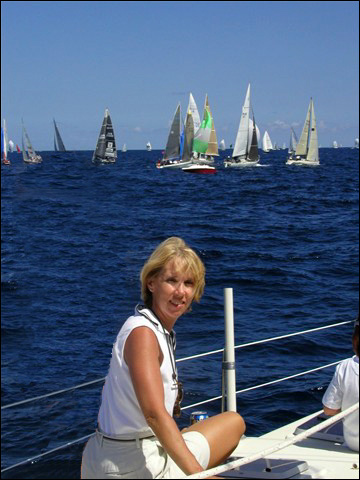 Before our role as committee boat for the Rolex Regatta, I had no idea what would be involved.
Before our role as committee boat for the Rolex Regatta, I had no idea what would be involved.
The concept, as I understood it, seemed simple enough: Clean up the boat then stay handy and out of the way at the same time.
The morning of the first day, a breeze blew through the salon and a quick look at the sky showed only a few puffy white spectator clouds.
We motored from our slip in Red Hook on the east end of St. Thomas to Cowpet Bay. Shortly after hooking a mooring ball we heard a dingy approach. It brought a delivery of large shopping bags of sandwiches, cans of soda and enough bottled water to float a fleet. Two more visits by the dinghy and the race committee was on board. Our 48’ catamaran, Take Two, was as crowded as we had ever seen her.
With an eye on the sky and a finger to the wind, the Principal Race Officer (PRO) immediately set to work with my husband examining charts in the salon and discussing where to position Take Two for the day’s races while the IT guy plugged his laptop into power at the chart table.
Outside, the flag bearer unrolled a long blue bundle onto the deck with a quick, sharp motion and selected flags for the day; and the gunner, a big man with a bushy black beard, set up a toy-size red cannon near the starboard stern. People were laying flag poles on the deck, attaching a white board to the boom, and placing directors chairs for the judges. I tried to look busy, but there is only so much activity involved in putting sodas in a cooler. After fetching tape for the white board, a stapler for a judge and more standing around, I decided to get out of everyone’s way and enjoy the event so I moved to the port stern and sat with my legs hanging over the side.
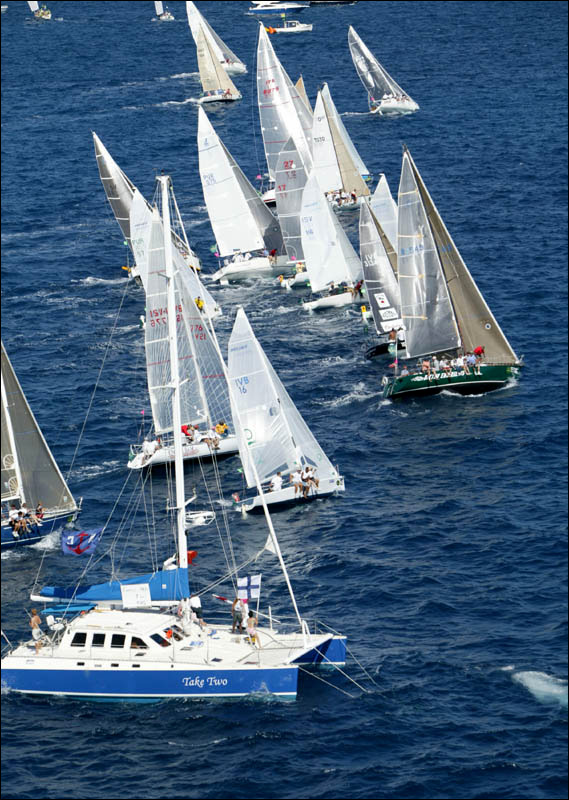 |
| TAKE TWO committee boat |
Nearly a hundred sailboats circled Take Two like Native Americans in their grandest head-dresses and war paint. The race committee hastily took down boat numbers while I took pictures. A few times I jerked my toes to safety as a clutch of boats crowded past close enough to knuckle bump.
The organization that goes into each race is complex and critically timed. Course information must be displayed on a white board; a sequence of flags are raised and lowered and a horn or the gun signals milestones in the sequence. Everything is strictly timed to the second. While dozens of boats bob and sway on the water, tacking and jockeying for position, countdown is playing out on the deck of the committee boat. The timer counts the seconds and issues orders to the flag raiser, gun shooter, and (with love to Dr. Seuss) horn honker. Starting several minutes before a race, the timer, with the mental discipline of a monk, tunes out all the activity on the deck and water around her and the sequence begins . . . “One minute to papa up and horn . . . thirty seconds to papa up and horn . . . ten seconds to papa up and horn . . . nine . . . eight . . .” Colorful flags go up on cue, remain for an exact number of minutes and are soon replaced with a flag conveying the next piece of information. Flags and horns tell the sailors which class is racing and how many minutes to the starting gun.
Coordination was just as critical for finishes. After a brief break, the committee moved chairs to starboard to prepare, as well as anyone could, for what was to come. The PRO selected a line of site between himself and the finish-line marker buoy; one volunteer grabbed a clipboard, another a stop-watch, and another the horn which he would blow when the first of a racing class crossed the finish line. I was recruited to help keep track of which classes had already crossed.
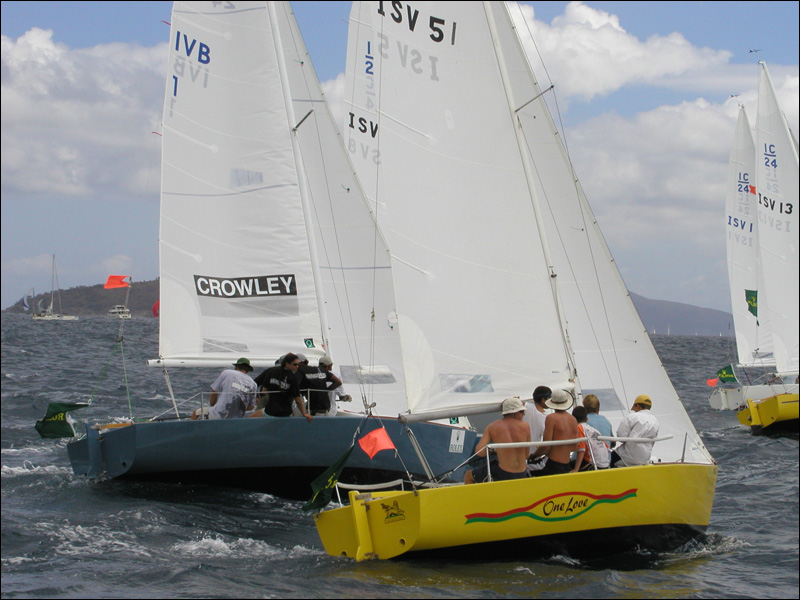
Nine classes raced. They ranged from lightweight little Beach Cats to the over 50′ class, and included Spinnaker Racing, Spinnaker Racing/Cruising, Non-spinnaker Racing, and J 24.
Beach cats are sporty and fun, but the monohulls are sexy. It’s a beautiful thing when the ocean reflects in the polished hull of a sailboat heeling close to the water; jib and main fat with the wind, moving with confidence and the elegance of a swan. The spinnaker classes painted the prettiest horizon. My camera clicked repeatedly as we watched a broken rainbow of colors scattered on the water racing toward us. The rainbow grew larger and more vivid until they flew past Take Two in a prismatic explosion of color and cheering voices.
Many finishes were exciting. Everyone got involved when a crowd of tightly clustered yachts approached. The PRO called out one yacht identification number after another, the timer called out the time and the information was scribbled onto forms. Anyone without a job backed up or doubled-checked the work of someone else. Once the rush passed, everyone took a breath and notes were compared to ensure accuracy.
As I watched the races more than ever I recognized just how fine a thing it is to race across open water propelled by nothing but the wind; to make a sport of something so much more than sport. A skill that can carry us around the world the way we have been traveling for thousands of years. To know the wind and just how to catch it, to know your vessel, what she’s capable of and how to bring out the best in her while exercising the best in yourself. That is competition at its finest.
About Connie Fleenor
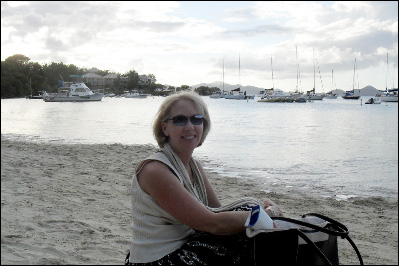 |
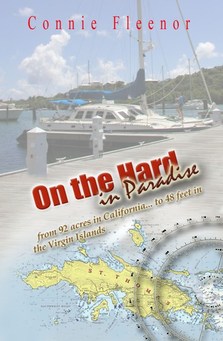 |
Connie Fleenor grew up in the soggy Pacific Northwest before moving to California where she lived in a condo in Silicon Valley while working at a software start-up during the exhilarating dotcom boom. In the late ’90s she moved to 92 acres of oak trees and scrub in the Sierra Nevada and from there to the U.S. Virgin Islands. You can read about her year living on a catamaran in the West Indies in her book On the Hard in Paradise.
Find out more about Connie Fleenor and her memoir at www.MangroveBooks.com


Lovely, passionate consideration of yacht racing,looks like it was super exciting!
A wonderfully evocative account of warm weather race management which brought back many memories!
It can be very different anchored in the middle of the night off the English Coast waiting for an offshore race fleet to arrive after 24 hours or more of slogging against wind, tide and rain but the abiding memory I have is of the dedication and good humour of the race team. Do hope you get another chance to volunteer soon.